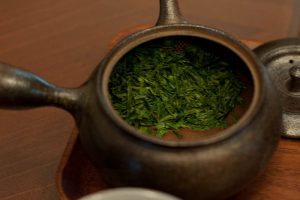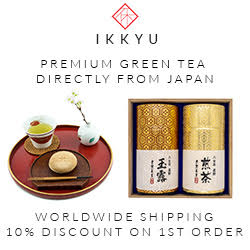
Shincha is one of the best green teas that Japan has to offer.
It’s a seasonal tea, because it’s only available during the first flush.
I hadn’t written about brewing shincha, but better late than never.
In truth, I used to brew it just like a sencha.
First of all I must say that there are different recommendations online, and at the end you should go by your personal taste, don’t just blindly follow what you read in this or any other tea blog 🙂
In other words, start with the general guideline and then experiment from there.
I did a preliminary research in Japanese websites, and found out that shincha is often brewed at 80 °C (176 °F).
This is counterintuitive because for higher grades of green tea it’s often better to brew at lower temperatures.
Eventually, this video from Kurihara Tea, plus other sources that described the same or similar parameters convinced me to prepare it that way.
It’s actually similar to the way that you would brew a fukamushi sencha.
Shincha brewing guidelines
Use 2 to 3 grams of shincha, 60 ml (2 oz) of water at 80 °C (176 °F), and infuse for 40 seconds.
The rationale is that by keeping the water at 80 °C, the aroma of this green tea is intensified. Also, the short brewing time keeps it from becoming bitter.
For the next re-infusions you can keep the same parameters, or perhaps shorten the infusion time.
As a side note, if it’s a fukamushi shincha, you should use 30 seconds and maybe consider lowering the temperature to 70 °C (158 °F). This type of tea can become bitter easily.
I’ve been preparing shincha this way and have liked it very much. Too bad I already drank most of it.
I guess I’ll have to wait until next year.






September 20, 2016
Thank you for the tips, Ricardo! I’m just waiting for some shincha from the Tea Crane and will try to make it at °C as you recommend…
September 20, 2016
Hi Valeria
Thanks for commenting.
I’ll try to meet with Tyas from the Tea Crane while in Kyoto. We both have a busy schedule during that time but I think that we can find the time.
September 21, 2016
WOW! I hope you’ll have a great time there! 🙂
September 24, 2016
There is a coterie of Japanese shincha drinkers who believe that it is best to let shincha age until the fall before drinking. I have tried this and found that shincha is sweeter and smoother then.
September 24, 2016
Hi Terry.
Japanese tea is often aged, it takes out some of the grassiness and it becomes more mellow. It also has to do with making sure that a particular harvest lasts all year in perfect condition, especially for matcha.
In shincha it must be true as well. But there’s the urgency of many tea drinkers of drinking the first harvest of the year, the fresher the better.
May 8, 2017
Hola Ricardo,
Thank you for all the information you put online. It helped me a lot when I was shopping for tea in Japan.
I just brew some shincha for me and my wife according to your instructions and it was just perfect!
May 8, 2017
Hi Javier
Thanks for your comment. Please enjoy your shincha, I’m glad that I was able to help.
September 3, 2017
Today i had my fukamushi sincha:
6gr / 100mL of water
50’C
40s brewing time
it tastes wonderful 🙂
September 3, 2017
Thank you for your comment Joshua.
Good to hear that you are enjoying your tea.
May 22, 2020
Thank you for the recommendations on temperature! I’ve been happy brewing my fukamushi-cha with 80ºC water. But, that’s just the one I have now. They can vary from one year to the next and from one store to the next. I wouldn’t brew every fukamushi with that temperature. There’s one shin-cha I have which is ideal at 75ºC. It’s, hands down, the best tea I’ve ever had. There’s not even a close second place. But, I got a shin-cha that’s supposed to be even higher grade than that one, which wasn’t good at 70ºC or 75ºC. I was very confused. I wondered if I got a bad batch or something. I’m just trying it with 80ºC water now. I hope that it turns out better. In terms of brewing the same leaves for another infusion, I typically either keep the time the same or increase it. I typically don’t decrease the temperature. But, if this variety is an exception in terms of temperature, it could be an exception in terms of duration, as well. So, I’ll definitely keep it in mind. 🙂
May 22, 2020
It turned out very well at 80ºC, thank you! The lower temperatures made me uncomfortable. The taste wasn’t great and the caffeine seemed to hit me in an unpleasant way. At 80ºC, it was very good.
Thank you, again! 🙂
May 22, 2020
Hi JD.
Good to hear that you liked it at that temperature.
Low temperature is good for getting an intense umami taste and no bitterness. However, sometimes we also want to enjoy the aroma, and so 80ºC works because some green teas aren’t bitter at that temperature anyway.
At the end, there’s no right or wrong way to do it. It’s up to you.
May 22, 2020
Hi, Ricardo, what I found interesting is that 80ºC was the only temperature it was even drinkable to me. For sencha or genmaicha, I can have it 80ºC one day and then 85ºC the next and it’s just a different flavor. With the shincha, it felt like a train wreck in tea form in terms of its affect on me, at any temperature below 80ºC. The only thing I can even compare it to is a bad ripened pu-erh that’s moldy (not golden flowers, bad mold) and has a terrible bodily effect to drink that’s really anxiety-provoking and uncomfortable. The only thing I can think is that a higher temperature does more to “clean” the tea of any contaminants or that it has some effect on the way caffeine, GABA, etc., are absorbed by water when brewing. It really is a science to brew tea as much as it is an art. 🙂